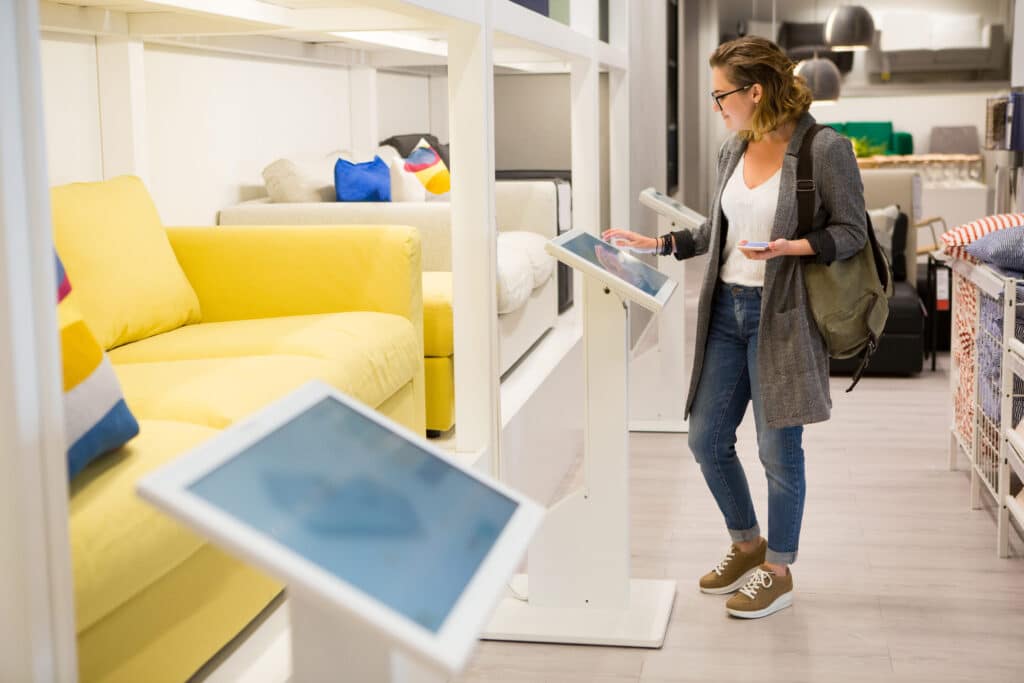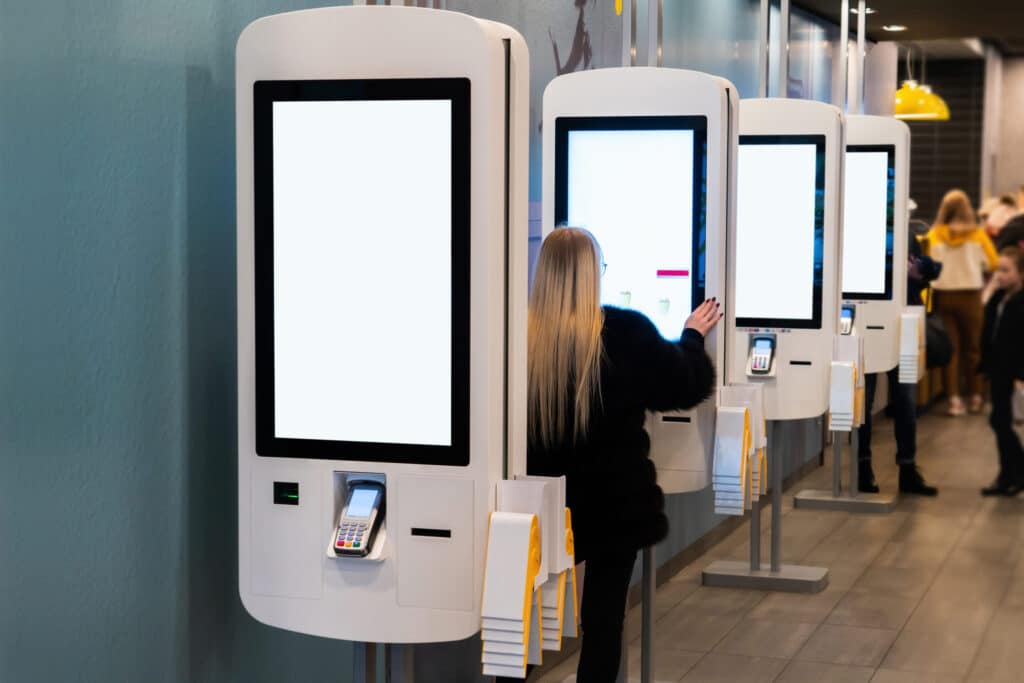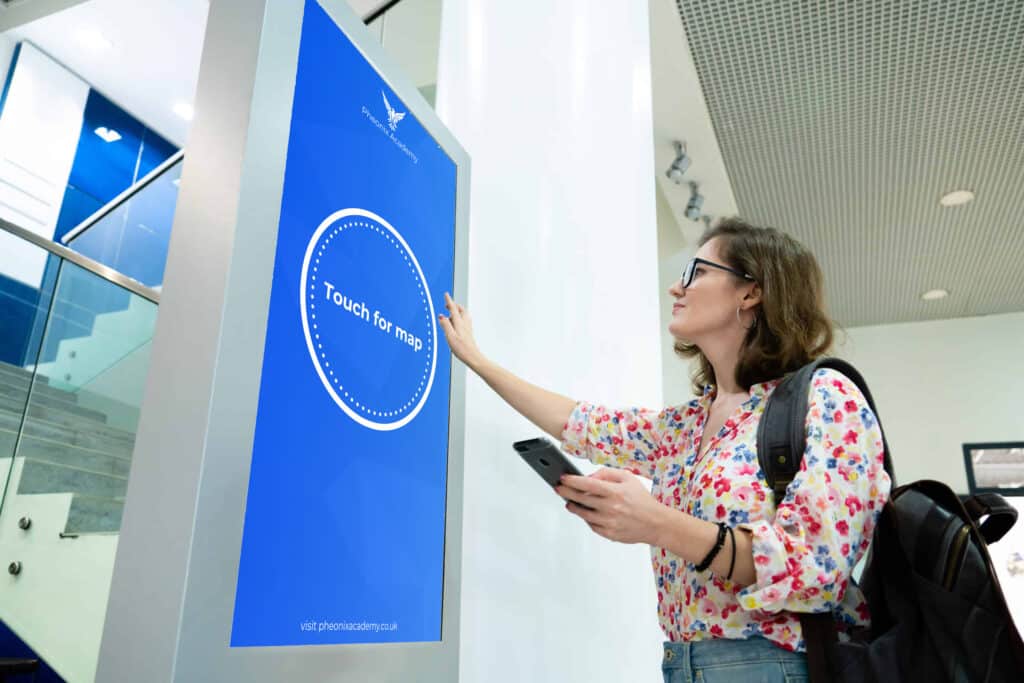As a frequent part of our daily lives, self-service and touch-screen kiosks are growing in popularity across industries, locations, and generations. Offering multiple advantages for consumers and businesses alike, digital kiosks are expected to reach a market share of $30.8 billion by 2024. Once few and far between, these information and service points have become common-place across most industries, with people having almost daily interactions with them.
In light of the exponential growth and increasing reliance on digital kiosks and self-service points, we have looked into how integrated they have become in people’s daily lives and how their increasingly heavy use of kiosks and screens gives rise to hygiene concerns that call for appropriate measures.
What Industries Use Self-Service Kiosks and Digital Screens, and How?
With the growing demand for convenience, efficiency, and cost-effectiveness, self-service kiosks and screens are becoming an integral part of the way people navigate through daily life. In our eyes, the technology is here to stay because they:
- Minimise waiting times
- Reduce time stress
- Help address health issues and ensure social distancing
- Increase customer satisfaction
From hospitality to healthcare, self-service kiosks and screens are providing a wide range of functionality to an array of industries and locations such as airports, retail stores, train stations, financial institutions and banks, pharmacies, and many more.
While they are used in numerous sectors, some of the front runners implementing self-service points and digital screens include:

Retail Sector – Retail Stores, Grocery Stores, Supermarkets
Interactive touchscreen kiosks are widely used in a variety of retail environments, and are increasingly replacing manned tills. Now, the vast majority of customers rely on the convenience of self-checkouts, along with self-service click-and-collect points, which also helps to speed up waiting/queuing times. For brands, kiosks and screens help buyers remember and recognise the companies they interact with, boosting brand awareness, according to the vast majority of U.K. retailers (84%).
Interactive screens and self-service retail kiosks can also help ease customer frustration by providing greater visibility on prices and live stock counts to avoid disappointment at the till.
Hospitality Industry
The hospitality industry has long been using interactive food ordering points or tablets to take orders. However, this has continued to grow in recent years, particularly in the fast-food sector, as restaurants have redesigned ordering and collection points.
Hotel Lobbies, Reception Areas
Hotel and restaurant guests can use digital signage and self-service kiosks to easily check in, find out about the local amenities, and have access to key guest information, and deals offered by their host.
Digital screens can also act as a virtual concierge service providing access to important information such as the services on offer, room service, safety procedures, and even event booking.
With 70% viewership, digital kiosks and screens installed in hotels have become one of the most effective forms of advertising and drive the highest awareness rate.
Quick-Service Restaurants (QSRs) and Fast Food Chains
Self-ordering kiosks have quickly become commonplace in most fast-food establishments. From skipping long queues to ease of payment, it’s no wonder we’ve seen fast-food leaders invest in this technology. Research shows that both kiosks and digital signage boards in QSRs, such as menus, have been said to raise the order values by 20-30%, with customers also twice as likely to order a dessert when using a kiosk, as they’re able to look through complete menus without time pressures.
Digital kiosks have also made their mark in the drive-thru. Drive-thru kiosks have revolutionised the in-car ordering experience, targeted promotions, and a more efficient ordering, go a long way in automating the ordering process making it more efficient and faster for customers and staff.

Healthcare Sector
Digital kiosks and screens installed in hospitals and clinics are helping to streamline healthcare operations as well as improving information accessibility and delivery. As a result, an impressive 75% of patients and caregivers report receiving better experiences and useful information. Dentists and pharmacies are also benefitting from the content-sharing capabilities of this self-service technology to offer smooth experiences to patients.
With screens, patients are able to speed up their check-in, often helping to reduce queue times at the reception desks. In addition, patients are often able to use these screens to get valuable information and directions using the available self-service kiosks, which could save an appointment slot.
Educational Institutions
Universities and schools use self-service kiosks for student registration, course selection, as well as other student services without contacting the staff, such as campus navigation with interactive digital wayfinding.
Students, staff, and visitors can find important information, schedules, and updates. While in university libraries, students can easily navigate through the extensive library catalogue to find authors and books, during busy periods or in a hurry.
What Are Self-Service Kiosks Typically Used for?
With their versatility and multiple functionalities, self-service kiosks and screens are used for doing various tasks avoiding in-person interactions, including:
- Shopping and payment processing
- Ordering products, including food and drinks
- Check-in and check-out
- Ticket purchasing
- Appointment scheduling
- Gathering feedback and survey data
- Information access and collecting
- Communicating company updates, important messages, and safety information

The Current Hygiene Concerns of Using Kiosks
With the use of public touchscreens exploding in popularity over the last few years, more focus is being put on the way people interact with them. We conducted a survey among consumers to find out how people typically interact with self-service kiosks.
Our survey results reveal, in 2023, an astounding 86% of people now use self-service food-ordering kiosks in public places, with almost 1 in 5 (18%) using them all the time and 43% using them more than half of the time. What’s more, those aged 18-34 are almost twice as likely to always use self-service kiosks to order food compared to those over 45.
The increasing popularity and use of self-service kiosks can come with some concerns around cleanliness. While most companies that use them conduct regular maintenance and cleaning on screens due to their constant high usage, this very reason can mean that customers might want to consider additional steps themselves.
In supermarkets, especially during busy times and peak shopping periods, the constant flow of people can make cleaning patterns for screens more irregular. This can be the same for food establishments that utilise these to speed up waiting times, as a result 4 in 10 people surveyed report that they have often found food-ordering self-service kiosks physically dirty, with wet, sticky, or smudged screens.
Despite all the efforts and campaigns devoted to raising public health awareness, only a quarter of people willingly sanitise their hands before using a public food-ordering kiosk, while almost a fifth (18%) of consumers don’t really think about it, admitting they never bother to do so.
On the other hand, although they interact with touchscreen points that almost 9 in 10 people use, only a third of people make sure to clean their hands after using a public self-service kiosk to order food. Almost a quarter (23%) of people only sanitise their hands once every four times they use a public touch screen.
How to Best Keep Screens Hygienic
In the fast-paced world we live in, it can be easy to forget the importance of maintaining good hygiene practices. From the customers using the self-ordering kiosks to the organisations providing them, it’s essential that we all take steps that ensure a clean, safe, convenient ordering experience.
Here are some tips for ensuring the cleanliness of self-service kiosks and screens:
- Create a regular cleaning schedule for all screens and touch points, where screens are cleaned with sanitising spray. Our research found 4 in 25 (16%) people found food-ordering self-service kiosks physically dirty/smudged every time they’ve used them – not only would routine cleaning bring this figure down, but also maintains good business standards for cleanliness. This doesn’t mean having all screens out of use at the same time, rather just do one screen at a time between uses.
- Clean all self-service and digital screens at the beginning and end of each business day. Although this might not be possible for places running 24 hours, establishing this type of routine can help ensure screens are clean and ready for each new day.
- Have hand sanitising stations, or hand sanitiser points available for customers with at least 60% alcohol to kill germs. This can also help to eliminate potential stickiness on screens, if a customer uses it before touching the screen.
- Consider having disposable sanitising/alcohol screen wipes available for customers who would want to use them. In some cases, staff may be too busy to get to a screen to clean it, or it could be a very busy period. Having accessible wipes that customers can use could help make them feel more comfortable using the screen, while also helping to keep it clean throughout the day.
By following these steps, organisations can make customers feel more comfortable and confident in using self-service and touch screen kiosks, and therefore improve their overall customer experience
If you have any questions or concerns related to keeping interactive digital kiosks and screens hygienic and safe, speak to an expert today.
—
Survey conducted on 2,000 UK adults, for a national representative, between 19th-23rd January 2023
